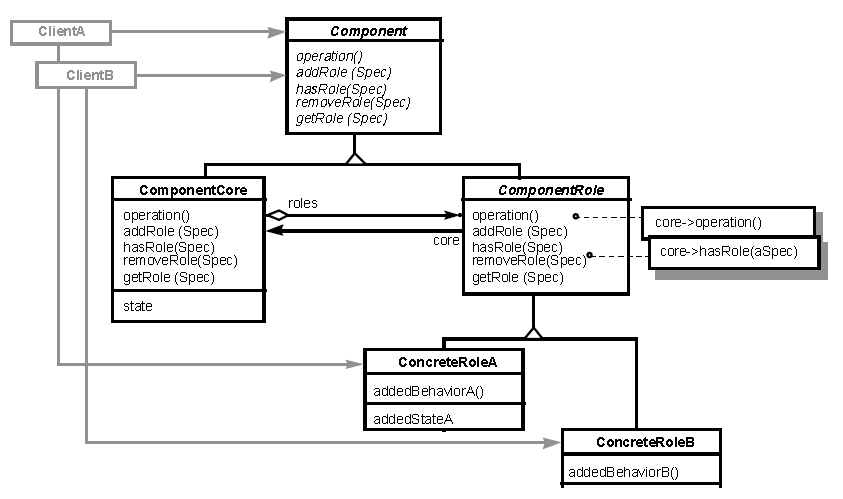Role Object(角色对象)
索引
通过明确地附加角色对象到目标对象中,以使对象可以适配不同的客户需求。每个角色对象都代表着目标对象在客户上下文中的一种角色。每种上下文都存在于特定的应用程序中,因此可使对象在不同的应用程序间解耦。
Adapt an object to different client’s needs through transparently attached role objects, each one representing a role the object has to play in that client’s context. Each context may be its own application, which therefore gets decoupled from the other applications.

Component
- 定义关键的抽象接口。
- 定义添加、删除、测试和查询角色对象的接口协议。Client 可以指定一个 specification 来获取一个 ConcreteRole 实例。
ComponentCore
- 实现 Component 接口,包括角色管理协议。
- 负责创建 ConcreteRole 实例。
- 管理角色对象。
ComponentRole
- 存储一个经过装饰的 ComponentCore 对象的引用。
- 实现 Component 接口,并将接口请求转发到 ComponentCore 中。
ConcreteRole
- 定义和实现特定上下文的 Component 接口的实现。
- 构造函数包含一个 ComponentCore 参数。
Client
- 请求协作对象。
当以下情况成立时可以使用 Role Object 模式:
- 你需要在不同的客户上下文间保持关键的抽象定义,每种抽象定义的实现都存在于其特定的应用范围内,同时你不想将这些与客户上下文相关的接口耦合在同一个接口内。
- 你需要能够动态的处理角色,以便可以在运行时按需的添加或移除角色,而不是在编译时使用固定的对象定义。
- 你需要保持角色与客户成对儿关系,在不同的角色与客户对之间保持独立性,当更改一个角色时并不影响其他客户。
- 可以简洁地定义对象的关键抽象。Component 接口仅需关注必要的状态的行为,而不会涉及具体上下文中的职责。
- 角色对象易于演进,彼此之间保持独立。
- 角色对象可以动态的添加和移除。
- 应用程序可以更好的解耦和。
- Decorator 模式与 Role Object 模式有着类似的结构,但行为不同。Decorator 模式使开发人员可以对一个对象进行链式的装饰,而 Role Object 模式则不允许这样。并且,Decorator 通常不会扩大对象的功能,而 Role Object 会引入新的操作。
- Extension Object 模式也在解决类似的问题,通过对对象的扩展来满足特定的客户上下文的需求。尽管如此,Extension Object 并没有考虑透明性(Transparently),即保持对象关键抽象(Key Abstraction)的定义,而 Role Object 则正是强调了这一点。
1 namespace RoleObjectPattern.Implementation1 2 { 3 public abstract class Customer 4 { 5 public abstract CustomerRole GetRole(string spec); 6 public abstract void AddRole(string spec); 7 public abstract void RemoveRole(string spec); 8 public abstract bool HasRole(string spec); 9 public abstract void SomeCommonOperation1(); 10 } 11 12 public class CustomerCore : Customer 13 { 14 private Dictionary<string, CustomerRole> _roles 15 = new Dictionary<string, CustomerRole>(); 16 private CustomerRoleFactory _roleFactory; 17 18 public CustomerCore(CustomerRoleFactory roleFactory) 19 { 20 _roleFactory = roleFactory; 21 } 22 23 public override CustomerRole GetRole(string spec) 24 { 25 if (_roles.ContainsKey(spec)) 26 return _roles[spec]; 27 else 28 return null; 29 } 30 31 public override void AddRole(string spec) 32 { 33 CustomerRole role = GetRole(spec); 34 if (role == null) 35 { 36 role = _roleFactory.CreateRole(spec, this); 37 if (role != null) 38 { 39 _roles.Add(spec, role); 40 } 41 } 42 } 43 44 public override void RemoveRole(string spec) 45 { 46 _roles.Remove(spec); 47 } 48 49 public override bool HasRole(string spec) 50 { 51 return _roles.ContainsKey(spec); 52 } 53 54 public override void SomeCommonOperation1() 55 { 56 // do some business logic 57 } 58 } 59 60 public class CustomerRole : Customer 61 { 62 private CustomerCore _decoratedCore; 63 64 public CustomerRole(CustomerCore core) 65 { 66 _decoratedCore = core; 67 } 68 69 public override CustomerRole GetRole(string spec) 70 { 71 return _decoratedCore.GetRole(spec); 72 } 73 74 public override void AddRole(string spec) 75 { 76 _decoratedCore.AddRole(spec); 77 } 78 79 public override void RemoveRole(string spec) 80 { 81 _decoratedCore.RemoveRole(spec); 82 } 83 84 public override bool HasRole(string spec) 85 { 86 return _decoratedCore.HasRole(spec); 87 } 88 89 public override void SomeCommonOperation1() 90 { 91 _decoratedCore.SomeCommonOperation1(); 92 } 93 } 94 95 public class Borrower : CustomerRole 96 { 97 public Borrower(CustomerCore core) 98 : base(core) 99 { 100 } 101 102 public void SomeOperationForBorrower() 103 { 104 // do something for borrower 105 } 106 } 107 108 public class Investor : CustomerRole 109 { 110 public Investor(CustomerCore core) 111 : base(core) 112 { 113 } 114 115 public void SomeOperationForInvestor() 116 { 117 // do something for investor 118 } 119 } 120 121 public class CustomerRoleFactory 122 { 123 public CustomerRole CreateRole(string spec, CustomerCore core) 124 { 125 CustomerRole newRole = null; 126 127 if (spec == "Borrower") 128 { 129 newRole = new Borrower(core); 130 } 131 else if (spec == "Investor") 132 { 133 newRole = new Investor(core); 134 } 135 136 return newRole; 137 } 138 } 139 140 public class Client 141 { 142 public void TestCase1() 143 { 144 Customer customer = new CustomerCore(new CustomerRoleFactory()); 145 customer.AddRole("Borrower"); 146 customer.AddRole("Investor"); 147 148 CustomerRole customerRole1 = customer.GetRole("Borrower"); 149 Borrower borrower = (Borrower)customerRole1; 150 borrower.SomeCommonOperation1(); 151 borrower.SomeOperationForBorrower(); 152 153 CustomerRole customerRole2 = customer.GetRole("Investor"); 154 Investor investor = (Investor)customerRole2; 155 investor.SomeCommonOperation1(); 156 investor.SomeOperationForInvestor(); 157 } 158 } 159 }
《设计模式之美》为 Dennis Gao 发布于博客园的系列文章,任何未经作者本人同意的人为或爬虫转载均为耍流氓。
